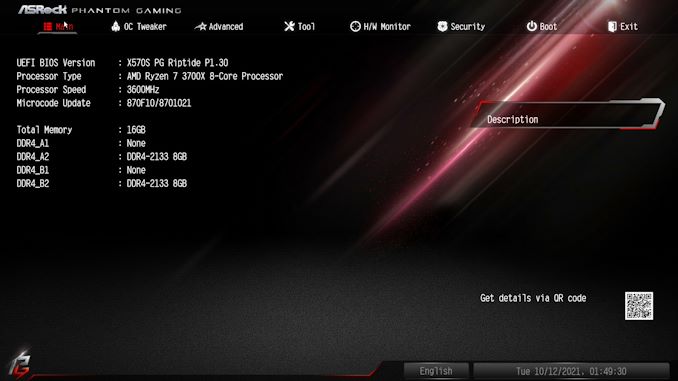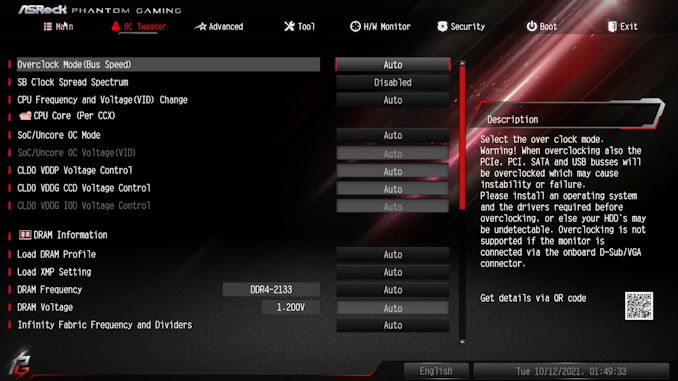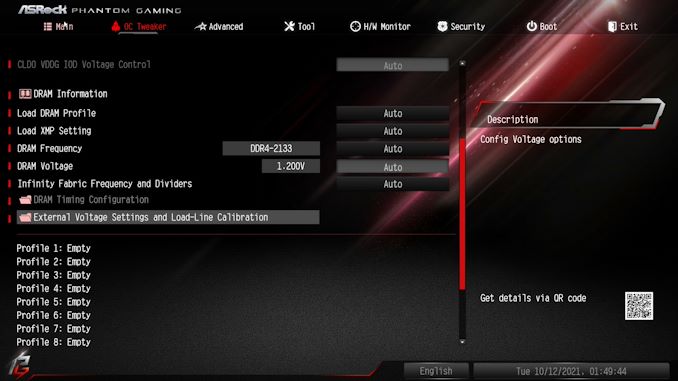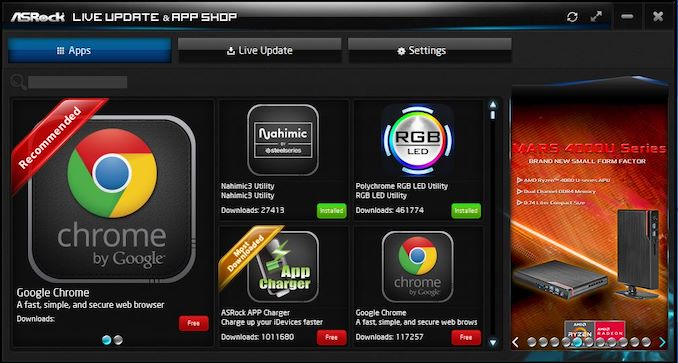The ASRock X570S PG Riptide Motherboard Review: A Wave of PCIe 4.0 Support on A Budget
by Gavin Bonshor on October 22, 2021 9:00 AM ESTBIOS
ASRock is using a consistent and familiar UEFI firmware across its Phantom Gaming series models for AMD's AM4 socket. The GUI consists of a primarily black background with red futuristic highlights, white text, and red highlighting when hovering over an option or menu.
The ASRock X570S PG Riptide UEFI firmware has just one mode which is resemblant of its Advanced modes on models that feature an EZ Mode as well. The main part of the firmware has plenty of menus to select from including (from left to right), the Main screen, the OC Tweaker, the Advanced section, the Tool menu, a H/W Monitor panel, a Security menu, a Boot menu, and an Exit menu.
The area where users can overclock is the OC Tweaker, which has plenty of options for users looking to overclock both the memory and processors. Users with AMD Ryzen APUs can also overclock the integrated Radeon graphics, with the options greyed out on unsupported processors.
There are many options for a budget board such as this in terms of both processor and memory overclocking, although much of it is simplified for users. Users can simply alter the CPU Frequency ratio and CPU VCore voltage and overclock the processor, although there are advanced CPU options such as Loadline Calibration and other voltage options to consider.
Users can also enable X.M.P 2.0 memory profiles on compatible memory kits with a couple of clicks, or alternatively, users can do this manually. ASRock provides lots of latency options for users looking to fine-tune their kits, providing there's any give or take in terms of overclocking. Users can also alter the Infinity Fabric Clock speed (FCLK), with the idea that it operates in a 2:1 ratio to provide the most effective levels of performance. The achievable FCLK varies on the chip, but a memory speed of DDR4-3600 and FCLK of 1800 MHz is seemingly achievable for most and is the sweet spot recommended by AMD.
While the level of customization for a board at this kind of price point lacks in some key areas to what we're used to. There is a basic element of its integrated FAN-Tastic fan tuning utility, but the firmware-based Polychrome RGB utility is lacking any visual expression, instead, users have to use color codes which is abysmal in this day and age. ASRock could be better as previously mentioned, but the rest of the firmware is fine, it's responsive, it's intuitive (aside from the parts mentioned above), and with more customization on the fan control and RGB LED lighting, it would be more than adequate.
Software
Compared to other AM4 boards from ASRock we've covered, the software bundle supplied with the X570S PG Riptide is very basic. The main software applications come via the Live Update and App Shop, with a Restart to UEFI which is a functional piece of software, as well as the Nahimic 3 audio software.
The ASRock Live Update and App Shop allows users to download the latest version of the software that is compatible with the X570S PG Riptide. It also allows users to download up-to-date drivers for the board including controller drivers such as networking, as well as AMD's latest chipset drivers at the click of a button.
Unfortunately, the ASRock X570S PG Riptide doesn't come supplied with any overclocking software such as A-Tuning or the Phantom Gaming series variant. Users looking to access overclocking tools within Windows can easily download the AMD Ryzen Master tuning utility, which we've used with great success previously and is very intuitive and easy to use. ASRock does include Nahamic too which is designed to enhance a user's auditory experience, and the Restart to UEFI software is also useful for directly booting into the firmware at the click of a button.
Overall it's not a feature-packed software bundle, but it's adequate and we still believe ASRock could have shipped one of its own overclocking software with this board.


























39 Comments
View All Comments
Arbie - Friday, October 22, 2021 - link
$185 - which you could spend on a set of aluminum lawn chairs. I am continually astounded that an ultra-high tech assembly like this, with hundreds of parts each microscopically created, comprising millions of transistors, and with multiple PCB layers, countless holes precisely drilled, and the whole thing electrically and electronically designed, all the drawings, BOM, logistics, testing etc, can appear on a shelf here at this price. Or at twice the price. Or three times.Just an observation...
meacupla - Friday, October 22, 2021 - link
That's because your aluminum lawn chairs are overpriced, and have significantly better margins. They probably only cost around $20 to make, $30 to ship, and $30 to store in a your local warehouse, until you bought them. That leaves more than a 50% profit margin for the manufacturer.Where as Mobos have significantly less margin. Mobo makers only have around 10% profit per sale of a mobo, and less than 8% on graphics cards, by the time you can buy one locally. This is also the reason why it's so hard to get RMAs on mobos and graphics cards for certain manufacturers.
Arbie - Friday, October 22, 2021 - link
So if lawn chairs cost half as much, mobos would be 0.5 x 10^6 more complex per dollar, instead of 1.0 x 10^6. I get it.TheITS - Friday, October 22, 2021 - link
It's much more logically explained by economies of scale, not complexity.Arbie - Friday, October 22, 2021 - link
I doubt that orders of magnitude more "ASRock X570S PG Riptide" mobos will be sold than say "Walmart Model XYZ" lawnchair sets. There are major economies of scale in the electronic subcomponents, but the lawnchairs have some too.Overall, I can far more easily see how lawnchairs might arrive at such a price than how a mobo can. In fact the latter appears miraculous compared to almost anything within 10x its price.
Wrs - Saturday, October 23, 2021 - link
Bulk is a primary cost factor for lawn chairs made abroad. It limits how many products you can pack per container for shipment. For a typical product originating from SE Asia, remember each container has to make the sea and land journey round trip. That typically ranges from $25000-40000 for a 40' truckload to the US, or $600-1000 per linear foot. This holiday season there are unusual shipping backlogs and the price has spiked to $2000 or something. Might not be the best year to get lawn chairs. A corollary is that the more compact the chairs fold or stack into, the cheaper they can be sold for.A mobo box being around 2 large books is comparatively easy to pack, but more importantly the tiny size of most of the components makes shipping costs to assembly site almost trivial. With Moore's law shrinking chips so much, one can still pack millions of transistors on a mature node for just pennies.
ballsystemlord - Friday, October 22, 2021 - link
Technical correction @Gavin . You didn't mean to write "... and three PCIe 4.0 x4 slots." You intended "... and three PCIe 4.0 x1 slots".geniekid - Friday, October 22, 2021 - link
How well does the GPU bracket/holder actually work?Tomatotech - Friday, October 22, 2021 - link
You know, I’m reading this mobo review after reading the details of the new M1 Pro / Max SoC, and all I can think of is that this mobo looks so large and outdated.I think it’s time for processors to start being soldered on, for Intel at least, as they change their sockets so often. I’d happily buy a CPU + mobo + decent igpu + ram + a TB or 2 of SSD space onboard. The whole package should cost less than buying the parts separately and work far better.
The cheaper CPUs can come with 8GB soldered on and the better ones with 16/32/64GB RAM options. 1 TB onboard of fast soldered SSD is enough for most people, and there can still be a M2 slot for adding a few more TB.
I’m not sure how to keep the ability to add a beefy GPU, maybe have a single high speed slot, plus the ability to add a daughterboard with a few more slots if needed, connected by a TB4 cable. (TB is basically PCIe over a cable).
Won’t be to everyone’s taste but it would make life easier and cheaper. Technology marches on and HDDs no longer have replaceable platters (drums), or replaceable arms / actuators. Time to take the next step and integrate the CPU and RAM, god knows Intel’s CPUs need a better RAM connection.
isthisavailable - Saturday, October 23, 2021 - link
How about no?